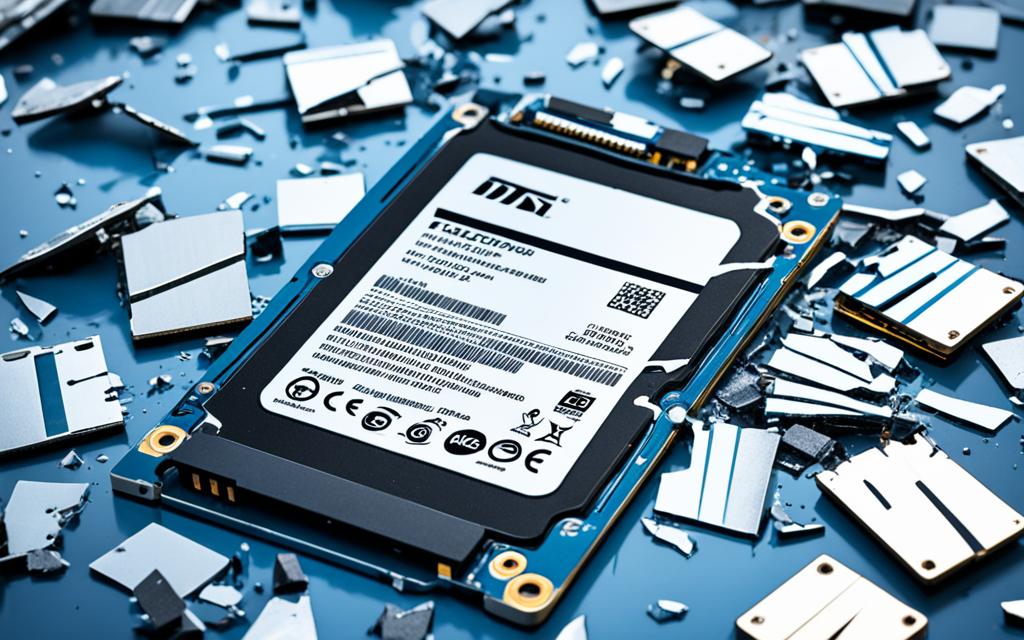Table of Contents
In the digital age, Solid State Drives (SSDs) shine with unmatched speed. They perform up to 20 times faster than old Hard Disk Drives (HDDs)1. But, it’s key to know the downsides of SSDs for smart choices on data storage. Issues with SSDs go beyond just the high cost. They include storage limits and possible reliability worries in tough conditions.
With SSDs becoming more common, it’s important to balance these challenges with their perks. This means finding the best data solutions that fit your needs. While SSDs are a big leap in tech, their drawbacks need serious thought before buying.
Key Takeaways
- SSDs are significantly faster than HDDs but come at a higher price point.
- The limited capacity of SSDs can restrict their usability for larger data needs.
- Data recovery from SSDs tends to be more challenging than from HDDs.
- Reliability issues may arise under certain conditions with SSDs.
- Considering both speed and cost is essential when choosing between SSDs and HDDs.
Introduction to SSD Drives
Solid State Drives (SSDs) have changed the game in storage solutions. They use advanced solid state drive technology for faster data access than Hard Disk Drives (HDDs). Unlike HDDs, which need moving parts to get data, SSDs use NAND memory. This tech reaches speeds from 100-600MB/s, way ahead of HDDs2. Because of this, operating systems and apps load much quicker. This makes SSDs the top pick for laptops and powerful PCs3.
More people are choosing SSDs recently. They last longer, use less power, and are more reliable since they don’t have moving parts2. But, they do cost more per gigabyte than HDDs. This higher price means you might get less storage space. This is an important point when you need lots of data storage4.
SSD shapes and sizes are also changing. There’s the common 2.5-inch SSD and new types like M.2 and U.2 SSDs. They’re becoming more common in homes and businesses3. Knowing about performance, lifespan, and how you’ll use it helps in choosing the right SSD.
Speed versus Capacity
Solid-state drives (SSDs) are known for their amazing speed, much faster than traditional hard disk drives (HDDs)5. Standard SATA SSDs excel in moving big files, with speeds up to 500 MB/s. In contrast, most HDDs work much slower, between 30 to 150 MB/s. Newer NVMe SSDs go even faster, from 3,000 to 3,500 MB/s, making them the top choice for those who seek performance.
When comparing storage capacity, SSDs and HDDs are quite different. HDDs have been the go-to for huge storage, offering up to 10 TB at cheaper prices, while SSDs usually offer up to 4 TB6. For those with big files like videos or databases, HDDs might be better because they offer more space for less money.
Even as SSD technology advances, they still have some limitations in the market. There’s a balance to find between the fast speeds of SSDs and the larger storage of HDDs. Understanding this balance is key when deciding to go for an HDD or an SSD, as each meets different storage needs and priorities.
What is the biggest drawback to SSD drives
Solid-State Drives (SSDs) have great technology but they come with big drawbacks. Two main issues are the cost of SSDs and their storage limitations.
Higher Cost of SSDs
One big problem with SSDs is they’re more expensive than Hard Disk Drives (HDDs). If you compare, SSDs can be two to three times pricier than HDDs for the same amount of storage7. This makes HDDs a better choice for those watching their budget.
For example, buying a 1TB HDD might only set you back £40 to £60. But, for a 1TB SSD, prices start at about £80. This makes per-gigabyte costs lower for HDDs. Especially for larger storage like 12TB, HDDs can be around £300, making them less than 3 pence per gigabyte.
Limited Storage Options
Even with improvements, SSDs still can’t match HDDs in storage size for the price. You rarely see consumer SSDs above 2TB. And when they do exceed 2TB, the prices are very high8.
In contrast, HDDs come in sizes from 1TB to 8TB at affordable prices7. This makes them more attractive for those with large media collections or those in content creation. Because SSDs are pricey, HDDs remain a popular choice for storing lots of data.
| Type | Storage Capacity | Cost |
|---|---|---|
| HDD | 1TB | £40 – £60 |
| SSD | 1TB | £80+ |
| HDD | 12TB | £300 – £350 |
| SSD | 2TB+ | Varies, often >£200 |
This table makes it clear the differences in cost and capacity between SSDs and HDDs. It shows why consumers choose one over the other.
Durability and Reliability Concerns
Durability and reliability of SSDs stand out compared to hard drives but have their own issues. They can last up to ten years, but factors like temperature changes, how much they’re used, and the type of data stored can speed up wear and tear9. This might reduce the SSD’s durability and affect how well it works.
SSDs have a specific number of write cycles, known as program/erase (P/E) cycles. These range from 500 to 100,000 cycles, depending on the SSD type10. SLC, MLC, TLC, and QLC SSDs vary in how durable and efficient they are. For example, the 2TB Samsung V-NAND 870 EVO has a TBW of 1,200, showing it’s very reliable10.
Yet, keeping your data safe is crucial since over 20% of SSDs can fail in four years9. If you start seeing file errors or bad blocks, your SSD might be close to failing. Doing regular updates and checking the SSD’s health can help make it last longer and prevent losing your data.
Data Recovery Challenges
Recovering data from SSDs can be quite complex, different from old-fashioned hard drives. SSDs use flash memory chips and have no moving parts. This makes recovering data from them tricky when they fail. How well recovery works depends on what caused the failure.
Difficulty in Data Recovery
SSDs have a unique design that can make data recovery difficult. For instance, if an SSD is slow, there’s a good chance data can be saved. But, if the computer can’t even find the SSD, the odds of getting data back drop to 50/5011. If someone formats an SSD but turns it off right after, getting data back is quite likely11.
When an SSD shows the wrong storage size, it’s hard to tell if data can be recovered, also 50/5011. Problems like the Blue Screen of Death don’t mean all is lost. With a high chance of recovery, especially if you haven’t run DSK CHK11.
SSDs can lose data for many reasons. Power surges, damaged components, overheating, and memory wear out can all cause failures12. For companies, losing data from an SSD can be really costly. It shows why good recovery services are essential12.
Water can also destroy SSDs, with a 50/50 chance of saving the data. If the SSD wasn’t used after getting wet, your chances are better11. It’s vital to back up your data regularly. Updates to SSD firmware can also help prevent loss12.
Performance Degradation Over Time
As SSDs get older, their performance starts to drop due to the impact of write cycles on SSD. Each memory cell can only handle a certain number of writes and erases. After that, it gets unreliable. This is a key concern as it could shorten the SSD’s life. The Write Amplification Factor (WAF) plays a big role in the SSD’s slowing down. It’s worse if the drive is used in a way that raises the WAF. That means the SSD has to write more data than needed, which slows it down.
Impact of Write Cycles
Imagine writing 128kb of data, but because the WAF is 4, the SSD actually writes 512kb13. This means a lot more writing than necessary, which can slow down the SSD over time. It’s a good idea to keep 10% to 30% of the SSD free. This helps avoid high WAF and keeps the SSD running well. Using overprovisioning can also lower the SSD’s WAF and keep it fast13.
Technologies like DymaxIO help SSDs last longer by improving how they write data13. They make sure SSDs have the space to write data in a neat row, which is faster than the messy way. Actually, writing data in a row not only speeds up the SSD but also makes it last longer13.
Different types of SSDs can handle a different number of writes before they stop working. For example, SLC drives can take 100,000 writes, but QLC drives might only manage 1,00014. As SSD technology gets better, it’s important for everyone to use their SSDs wisely. This helps get the most out of the SSD’s speed and life.
Conclusion
In conclusion, it’s important to note that SSDs offer fast and efficient performance but have downsides too. They are more expensive than HDDs, often costing a lot more per gigabyte15. Plus, they don’t hold as much data, requiring users to consider their storage needs carefully. Advanced SSDs like Intel’s 32TB model still can’t beat HDDs in sheer storage capacity.
SSDs also face reliability issues and limited write cycles, between 1,000 and 10,000 times16. If they fail, recovering data can be tough due to their unique build. So, this pushes users to think hard about whether an SSD or HDD is right for them. HDDs might be better for those needing lots of space.
Knowing the pros and cons of SSDs helps users choose the right storage option. It allows them to match their storage needs with what each technology offers. With this insight, choosing between an SSD and an HDD becomes clearer, guiding personal or professional storage decisions.
FAQ
What are the main drawbacks of SSD drives?
SSD drives are pricier and hold less data than hard drives. They may also have reliability issues. Recovering data from them can be tough.
How do SSDs compare in speed to HDDs?
SSDs are much quicker than HDDs, with speeds up to 3,500 MB/s for some. This means your computer starts faster and accesses data quicker.
Are SSDs worth the investment despite their higher price?
Despite their cost, SSDs offer speed and durability that many find valuable. They’re especially good for tasks needing quick data access.
How can I ensure the longevity of my SSD?
To make your SSD last longer, don’t write too much data to it. Keep it cool and back up your data regularly. This helps prevent data loss if it fails.
What should I consider when choosing between an SSD and an HDD?
If you need fast performance for gaming or editing, get an SSD. HDDs are better for lots of storage without spending much.
What are the challenges associated with SSD data recovery?
Recovering data from SSDs is hard because of the TRIM command. This command deletes data in a way that’s hard to undo. You might need special services to get your data back.
Are there different types of SSDs available?
Yes. You can choose from SATA, NVMe, and M.2 SSDs. Each type offers different performance levels, depending on what you need.
How does the performance of SSDs degrade over time?
SSDs can slow down because they have a limited number of write cycles. Writing too much data to them can make them slower. So, it’s important to use them wisely.
Source Links
- https://datarecovery.com/rd/the-pros-and-cons-of-ssds-as-external-hard-drives/ – The Pros and Cons of SSDs as External Hard Drives – Datarecovery.com
- https://www.geeksforgeeks.org/introduction-to-solid-state-drive-ssd/ – Introduction to Solid-State Drive (SSD) – GeeksforGeeks
- https://www.techtarget.com/searchstorage/definition/SSD-solid-state-drive – What is an SSD (Solid-State Drive)?
- https://www.ibm.com/topics/solid-state-drives – What Is a Solid-State Drive? | IBM
- https://www.avast.com/c-ssd-vs-hdd – SSD vs. HDD: Which Do You Need?
- https://www.crucial.com/articles/about-ssd/ssd-vs-hdd – SSD vs HDD: Know the Difference
- https://www.pcmag.com/news/ssd-vs-hdd-whats-the-difference – SSD vs. HDD: What’s the Difference?
- https://blog.purestorage.com/purely-educational/ssd-vs-hdd-speeds-whats-the-difference/ – SSD vs. HDD Speeds: What’s the Difference?
- https://www.n-able.com/blog/ssd-lifespan – SSD Lifespan: How Long do Solid-State Drives Last? – N-able
- https://www.backblaze.com/blog/how-reliable-are-ssds/ – Are Solid State Drives / SSDs More Reliable Than HDDs?
- https://www.fivestardatarecovery.com/data-recovery/ssd-data-recovery/ – SSD Drive Data Recovery | Five Star Data Recovery
- https://cbldata.com/services/ssd-data-recovery/ – Solid State Drive (SSD) Data Recovery Services
- https://condusiv.com/do-ssds-degrade-over-time/ – Do SSDs Degrade Over Time?
- https://serverfault.com/questions/986772/ssd-or-hdd-for-server – SSD or HDD for server
- https://www.backblaze.com/blog/hdd-versus-ssd-whats-the-diff/ – A Look at the Differences Between SSD and HDD
- https://www.sciencedirect.com/topics/computer-science/solid-state-drive – Solid State Drive – an overview








